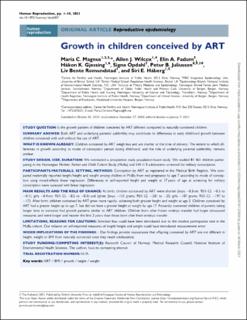| dc.contributor.author | Magnus, Maria Christine | |
| dc.contributor.author | Wilcox, Allen J. | |
| dc.contributor.author | Fadum, Elin Anita | |
| dc.contributor.author | Gjessing, Håkon | |
| dc.contributor.author | Opdahl, Signe | |
| dc.contributor.author | Juliusson, Petur Benedikt | |
| dc.contributor.author | Romundstad, Liv Bente | |
| dc.contributor.author | Håberg, Siri Eldevik | |
| dc.date.accessioned | 2021-03-15T16:06:11Z | |
| dc.date.available | 2021-03-15T16:06:11Z | |
| dc.date.created | 2021-03-04T11:34:24Z | |
| dc.date.issued | 2021 | |
| dc.identifier.citation | Human Reproduction. 2021, 1-9. | en_US |
| dc.identifier.issn | 0268-1161 | |
| dc.identifier.uri | https://hdl.handle.net/11250/2733498 | |
| dc.description.abstract | STUDY QUESTION: Is the growth pattern of children conceived by ART different compared to naturally conceived children.
SUMMARY ANSWER: Both ART and underlying parental subfertility may contribute to differences in early childhood growth between children conceived with and without the use of ART.
WHAT IS KNOWN ALREADY: Children conceived by ART weigh less and are shorter at the time of delivery. The extent to which differences in growth according to mode of conception persist during childhood, and the role of underlying parental subfertility, remains unclear.
STUDY DESIGN, SIZE, DURATION: We conducted a prospective study population-based study. We studied 81 461 children participating in the Norwegian Mother, Father and Child Cohort Study (MoBa) and 544 113 adolescents screened for military conscription.
PARTICIPANTS/MATERIALS, SETTING, METHODS: Conception by ART as registered in the Medical Birth Registry. We compared maternally reported length/height and weight among children in MoBa from mid-pregnancy to age 7 according to mode of conception using mixed-effects linear regression. Differences in self-reported height and weight at 17 years of age at screening for military conscription were assessed with linear regression.
MAIN RESULTS AND THE ROLE OF CHANCE: At birth, children conceived by ART were shorter (boys 0.3 cm; 95% CI, 0.5 to 0.1), girls 0.4 cm; 95% CI, 0.5 to 0.3) and lighter (boys 113 grams; 95% CI, 201 to 25, girls 107 grams; 95% CI, 197 to 17). After birth, children conceived by ART grew more rapidly, achieving both greater height and weight at age 3. Children conceived by ART had a greater height up to age 7, but did not have a greater height or weight by age 17. Naturally conceived children of parents taking longer time to conceive had growth patterns similar to ART children. Children born after frozen embryo transfer had larger ultrasound measures and were longer and heavier the first 2 years than those born after fresh embryo transfer.
LIMITATIONS, REASONS FOR CAUTIONS: Selection bias could have been introduced due to the modest participation rate in the MoBa cohort. Our reliance on self-reported measures of length/height and weight could have introduced measurement error.
WIDER IMPLICATIONS OF THE FINDINGS: : Our findings provide reassurance that offspring conceived by ART are not different in height, weight or BMI from naturally conceived once they reach adolescence.
STUDY FUNDING/COMPETING INTEREST(S): Research Council of Norway; Medical Research Council; National Institute of Environmental Health Sciences. The authors have no competing interest.
TRIAL REGISTRATION NUMBER: N/A. | en_US |
| dc.language.iso | eng | en_US |
| dc.publisher | Oxford University Press (OUP) | en_US |
| dc.rights | Navngivelse-Ikkekommersiell 4.0 Internasjonal | * |
| dc.rights.uri | http://creativecommons.org/licenses/by-nc/4.0/deed.no | * |
| dc.title | Growth in children conceived by ART | en_US |
| dc.type | Peer reviewed | en_US |
| dc.type | Journal article | en_US |
| dc.description.version | publishedVersion | en_US |
| dc.source.pagenumber | 1-9 | en_US |
| dc.source.journal | Human Reproduction | en_US |
| dc.identifier.doi | 10.1093/humrep/deab007 | |
| dc.identifier.cristin | 1895573 | |
| dc.relation.project | Norges forskningsråd: 262700 | en_US |
| dc.description.localcode | VC The Author(s) 2021. Published by Oxford University Press on behalf of European Society of Human Reproduction and Embryology. This is an Open Access article distributed under the terms of the Creative Commons Attribution Non-Commercial License (http://creativecommons.org/licenses/by-nc/4.0/), which permits non-commercial re-use, distribution, and reproduction in any medium, provided the original work is properly cited. For commercial re-use, please contact journals.permissions@oup.com | en_US |
| cristin.ispublished | true | |
| cristin.fulltext | original | |
| cristin.qualitycode | 2 | |

